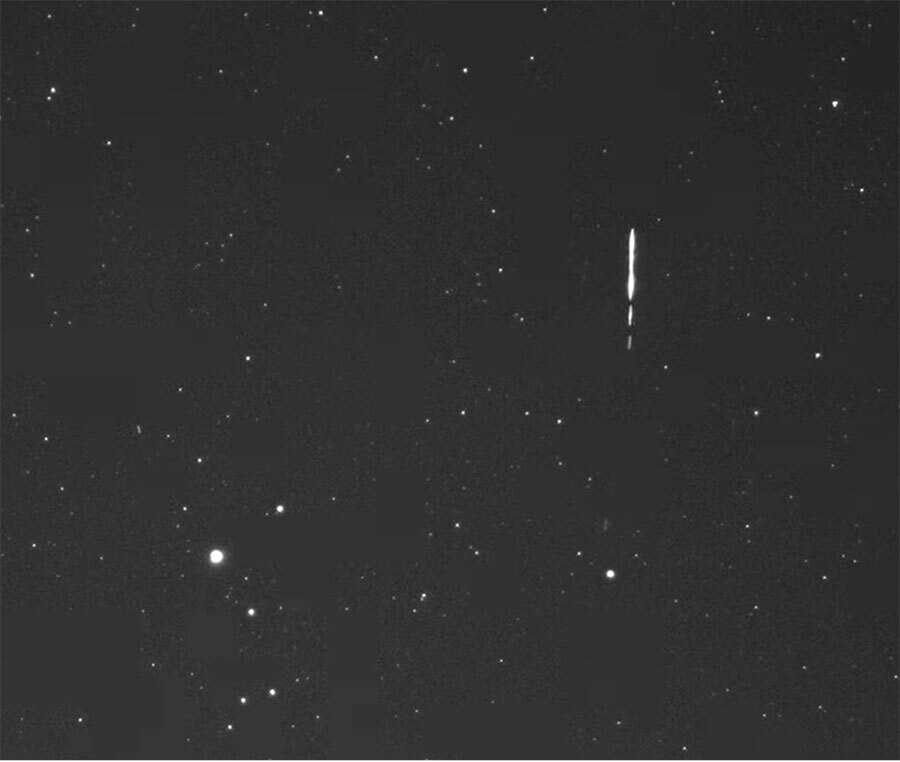28.08.2024
OBSERVERS’ REPORT: FIRST VIEWS OF THE CHINESE “THOUSAND SAILS” SATELLITES
Amateur astronomers have shown that the first satellites of the Chinese Qianfan (“Thousand Sails”) constellation are bright enough to be seen naked-eye.


Ourspace
Shanghai SatCom Satellite Technology launched the first 18 spacecraft of their Qianfan megaconstellation in early August. Qianfan means Thousand Sails and it will add 14,000 new communication satellites to the already crowded space in low-Earth orbit. Two more Chinese mega-constellations are planned to follow Qianfan.
The Thousand Sails spacecraft are in polar orbits inclined 89° to Earth’s equator at altitudes near 800 kilometers (500 miles). That height is above the Starlink satellites, operated by SpaceX, and below those of the OneWeb constellation from Eutelsat.
The China Aerospace Science and Technology Corporation called the deployment a complete success; however, a rocket mishap occurred on the following day. The U.S. Space Force (USSF) reported that the Long March 6A launch vehicle, a new liquid-fuel rocket with solid-fuel boosters, broke apart, leaving a field of orbital debris.

Slingshot Aerospace
Several observers recorded the satellites as well as the destroyed rocket, some even before the USSF published ephemeris information one week later. A video by Kevin Fetter of Ontario, Canada, made on the day after launch shows the string of Qianfan spacecraft emerging from eclipse by Earth’s shadow. Thomas Laskowsky of Bourbon, Indiana, was watching the Perseid meteor shower on August 11th when he noticed the Qianfan satellite train.

Kevin Fetter / YouTube
Nick James of Tillingham, UK, recorded video of the satellites, which passed near his zenith on August 12th. Meanwhile, Cees Bassa of the Netherlands Institute for Radio Astronomy postedpositional data for numerous rocket fragments.

Nick James / nickdjames.com
Experienced visual satellite observers began recording brightness once the ephemeris data became available. Richard Cole in southwestern UK informed me that the spacecraft were magnitude 4.6 on August 15th. Bram Dorreman measured 6.1 and 5.1 on successive passes over northern Belgium on August 16th. I gauged them to be magnitude 5.2 a few hours later from Bowie, Maryland, and then at 5.8 on August 21st.
Cole, Dorreman, and I observed the Qianfan satellites between 28° and 54° above our local horizons. The data indicate brighter magnitudes at greater heights and suggest that the spacecraft shine at about magnitude 4 near zenith. That brightness compares to the magnitude 4.3 that I derived from Nick James’ video, which he recorded as the satellites passed almost straight overhead.

Anthony Mallama
Information about the Chinese spacecraft themselves is only slowly emerging. Thousand Sails personnel are quoted as stating that the spacecraft have a “standardized and modular” flat-panel design that would make them similar in shape to Starlink satellites; however, news articles from China lack specific details.
MORE ON THE WAY
Besides the Thousand Sails project, two other large Chinese satellite constellations are under development. The China National Network Group is planning for 13,000 spacecraft in their Guowang (also referred to as SatNet) constellation. And commercial manufacturer Landray Hongqing is building the Crane-3 constellation, which will field an anticipated 10,000 more satellites according to the company’s filings. Altogether, the three constellations would tally up to 37,000 spacecraft.
The combined number of American and Chinese satellites for internet and cell phone connectivity will thus likely exceed 60,000. Communication spacecraft launched by other countries as well as satellites for military and various commercial applications may push the total past 100,000.
The Thousand Sails spacecraft at their current brightness would seriously interfere with astronomical research as well as aesthetic appreciation of the night sky. In the U.S., SpaceX is working with astronomers to address the problem of bright spacecraft, and Starlink has succeeded in reducing the brightness of its satellites by 90%. There are, however, no regulations in place as yet that govern satellite brightness. We can only hope that Chinese spacecraft operators will diminish the brightness of Thousand Sails satellites and other constellations.
In a worldwide effort to address and remediate the impact of bright spacecraft, the International Astronomical Union sponsors a Centre for the Protection of Dark and Quiet Skies from Satellite Constellation Interference. The IAU-CPS is studying the brightness of satellite constellations including Qianfan. Visual observers wishing to measure satellite magnitudes can find instructions here. Predictions of satellite visibility for any location are available at Heavens-Above.
Quelle: Sky&Telescope
